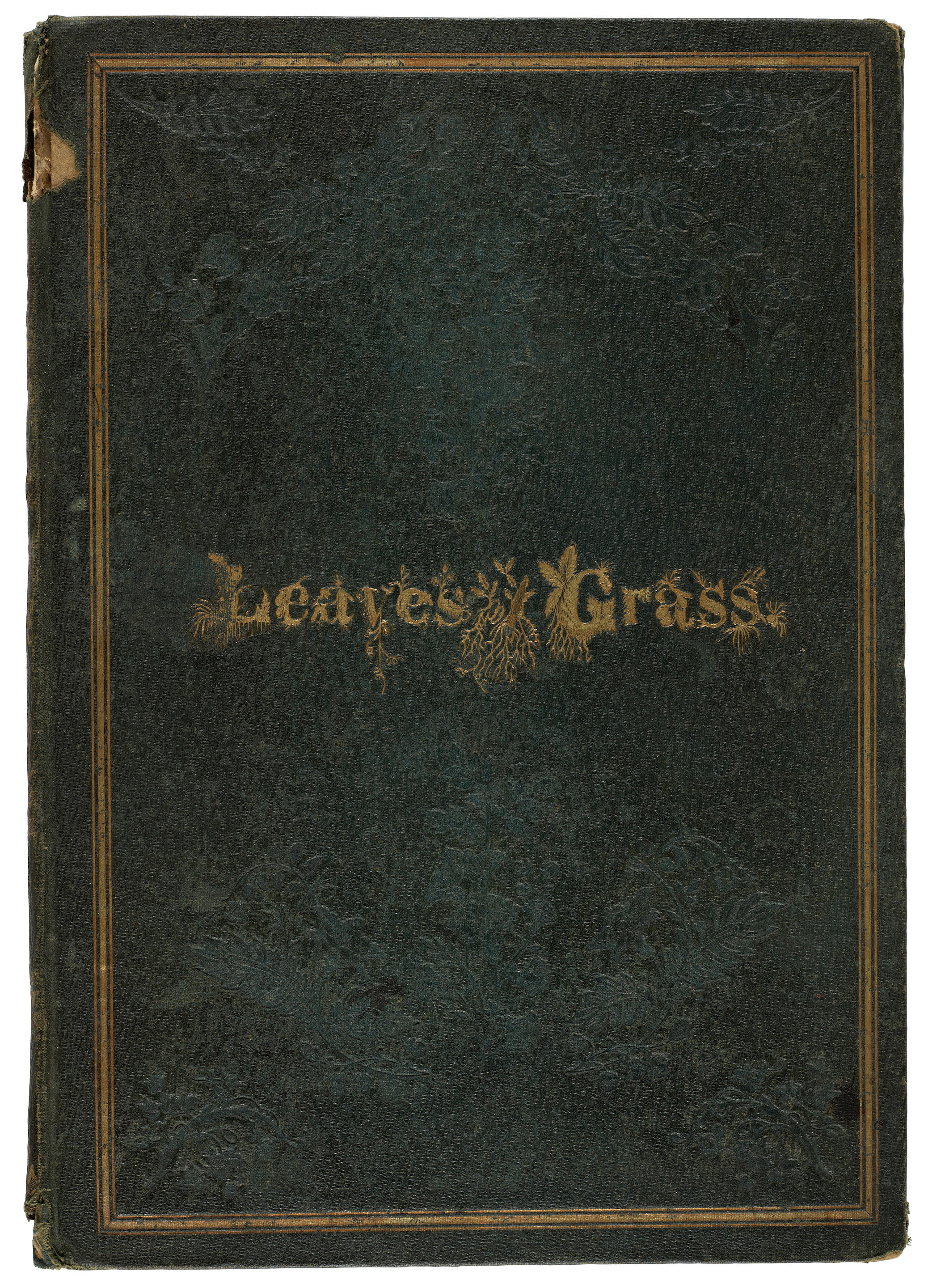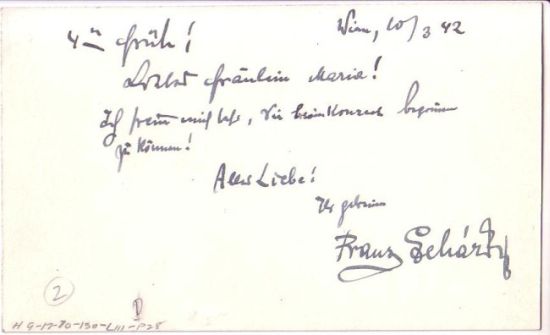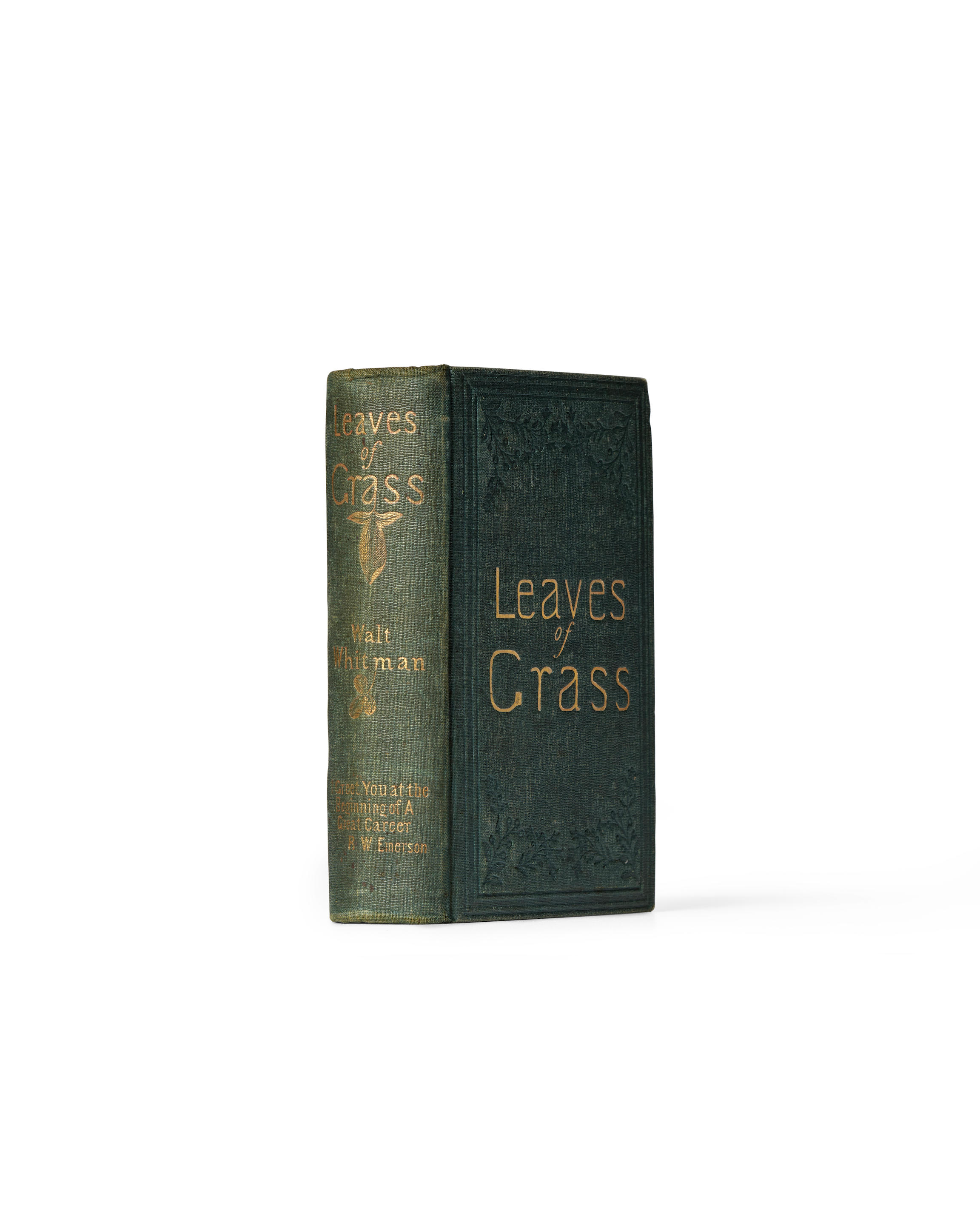Details
“I greet you at the beginning of a great career...”
First edition of Leaves of Grass, with Emerson broadside
WHITMAN, Walt (1819-1892). Leaves of Grass. Brooklyn: [Printed for the Author], 1855.
“I greet you at the beginning of a great career...”
The first edition, first issue of Leaves of Grass; together with the Jerome Kern copy of the excessively rare broadside printing of Emerson’s famed acclamatory letter to Whitman. Leaves of Grass was Whitman’s first book. The poet himself, a working-class Brooklynite, privately printed the book and it was distributed by the phrenologists Fowler & Wells rather than by a mainstream bookseller. Leaves of Grass could well have languished unnoticed if it had not been for Ralph Waldo Emerson’s strong and immediate endorsement and Whitman's own promotion of that endorsement.
In the spring of 1855, Whitman was spending nearly every day at the printing office of James and Thomas Rome in Brooklyn, “writing, revising, reading proof, even working at the type case, just as he had done twenty years earlier as an apprentice printer. Altogether he set in type about ten of the ninety-five pages of a book that he also designed, produced, published, promoted ... The 795 copies the Romes ran off on their hand press and delivered to the binder were all there were or could be of the first edition. No plates were made; the book was printed from type, and the type distributed" (Kaplan, Walt Whitman, 1982, p. 198). According to Myerson, 337 of these copies were bound in June and July of 1855 in the present, “Binding A,” the most expensive and earliest version of the binding, with both covers gilt-stamped and all paper edges gilt.
This first, most deluxe version of Leaves of Grass is what R.W. Emerson received at home in Concord, Massachusetts that summer from Walt Whitman, his unknown admirer. His reply to Whitman’s unsolicited gift has become legendary. It is quoted in full in the broadside present here.
Whitman was so enraptured on receiving this letter that he carried it around with him all summer—“thus armored against the most brutal onslaughts of the critics” (Allen, The Solitary Singer, 1960, p. 152). However, Whitman faced something worse than onslaughts: silence. Emerson’s letter arrived within days of Charles A. Dana’s friendly and positive review in the New York Tribune, but that single review was then followed by a long lapse of public notice. By fall, Whitman took matters into his own hands and succeeded in publishing three separate reviews, all written by himself(!). Whitman knew the newspaper business very well and worked his advantages shrewdly. On 10 October 1855, he allowed Dana to publish Emerson’s letter in the New York Tribune—without consulting Emerson. This was a breach of etiquette that horrified some but was incredibly effective. Subsequent review copies were sent with the newspaper clipping of the letter but that was soon supplanted by the very elegant broadside version present here. The broadside is headed, “Copy for the convenience of private reading only.” By 1856, Whitman had dropped all pretense of modesty and not only printed Emerson’s letter in the front matter of the second edition, but emblazoned a quotation from it on the volume’s spine in gold letters. The elegant and ephemeral first separate printing of Emerson’s famous letter is incredibly rare. The item first appeared in the marketplace in the Stephen Wakeman auction in 1924, catalogued as “one of two known copies: the rarest Emerson item.”
The volume is in BAL's and Myerson's Binding A, with first state of the frontispiece portrait (on heavy paper), second state of the copyright page as usual, and second state of p. iv. BAL 21395 & 21503/5225 (broadside is listed under both Emerson and Whitman); Grolier American 67; Myerson A2.I.a1 (Whitman) and A23 (Emerson); PMM 340.
Volume: Folio (287 x 205mm). Engraved frontispiece portrait with tissue guard. Original green cloth, gilt-lettered and decorated in blind on front and back covers within a triple gilt rule, gilt-lettered and decorated spine, marbled endpapers, gilt edges (small, unobtrusive repairs at spine ends of spine, slightest wear to tips, skillfully tightened in binding, small oval library duplicate rubber stamp on verso of title-leaf); modern clamshell case. Provenance: Howard Motley Hayes (bookplate) – Lenox Library, New York Public Library (stamp as above) – Christie’s New York, 14 December 2000, lot 148.
Letter: Printed broadside, 148 x 121mm, on white wove paper (skillfully repaired hole at middle top with two words and a few letters in facsimile, a smaller repaired marginal hole, old crease); modern polished calf chemise (scuffed, backstrip worn); and half morocco folding box. Provenance: Jerome Kern (morocco bookplate to chemise, his sale, Anderson Galleries, 21-24 January 1929, lot 1438).
Details
“I greet you at the beginning of a great career...”
First edition of Leaves of Grass, with Emerson broadside
WHITMAN, Walt (1819-1892). Leaves of Grass. Brooklyn: [Printed for the Author], 1855.
“I greet you at the beginning of a great career...”
The first edition, first issue of Leaves of Grass; together with the Jerome Kern copy of the excessively rare broadside printing of Emerson’s famed acclamatory letter to Whitman. Leaves of Grass was Whitman’s first book. The poet himself, a working-class Brooklynite, privately printed the book and it was distributed by the phrenologists Fowler & Wells rather than by a mainstream bookseller. Leaves of Grass could well have languished unnoticed if it had not been for Ralph Waldo Emerson’s strong and immediate endorsement and Whitman's own promotion of that endorsement.
In the spring of 1855, Whitman was spending nearly every day at the printing office of James and Thomas Rome in Brooklyn, “writing, revising, reading proof, even working at the type case, just as he had done twenty years earlier as an apprentice printer. Altogether he set in type about ten of the ninety-five pages of a book that he also designed, produced, published, promoted ... The 795 copies the Romes ran off on their hand press and delivered to the binder were all there were or could be of the first edition. No plates were made; the book was printed from type, and the type distributed" (Kaplan, Walt Whitman, 1982, p. 198). According to Myerson, 337 of these copies were bound in June and July of 1855 in the present, “Binding A,” the most expensive and earliest version of the binding, with both covers gilt-stamped and all paper edges gilt.
This first, most deluxe version of Leaves of Grass is what R.W. Emerson received at home in Concord, Massachusetts that summer from Walt Whitman, his unknown admirer. His reply to Whitman’s unsolicited gift has become legendary. It is quoted in full in the broadside present here.
Whitman was so enraptured on receiving this letter that he carried it around with him all summer—“thus armored against the most brutal onslaughts of the critics” (Allen, The Solitary Singer, 1960, p. 152). However, Whitman faced something worse than onslaughts: silence. Emerson’s letter arrived within days of Charles A. Dana’s friendly and positive review in the New York Tribune, but that single review was then followed by a long lapse of public notice. By fall, Whitman took matters into his own hands and succeeded in publishing three separate reviews, all written by himself(!). Whitman knew the newspaper business very well and worked his advantages shrewdly. On 10 October 1855, he allowed Dana to publish Emerson’s letter in the New York Tribune—without consulting Emerson. This was a breach of etiquette that horrified some but was incredibly effective. Subsequent review copies were sent with the newspaper clipping of the letter but that was soon supplanted by the very elegant broadside version present here. The broadside is headed, “Copy for the convenience of private reading only.” By 1856, Whitman had dropped all pretense of modesty and not only printed Emerson’s letter in the front matter of the second edition, but emblazoned a quotation from it on the volume’s spine in gold letters. The elegant and ephemeral first separate printing of Emerson’s famous letter is incredibly rare. The item first appeared in the marketplace in the Stephen Wakeman auction in 1924, catalogued as “one of two known copies: the rarest Emerson item.”
The volume is in BAL's and Myerson's Binding A, with first state of the frontispiece portrait (on heavy paper), second state of the copyright page as usual, and second state of p. iv. BAL 21395 & 21503/5225 (broadside is listed under both Emerson and Whitman); Grolier American 67; Myerson A2.I.a1 (Whitman) and A23 (Emerson); PMM 340.
Volume: Folio (287 x 205mm). Engraved frontispiece portrait with tissue guard. Original green cloth, gilt-lettered and decorated in blind on front and back covers within a triple gilt rule, gilt-lettered and decorated spine, marbled endpapers, gilt edges (small, unobtrusive repairs at spine ends of spine, slightest wear to tips, skillfully tightened in binding, small oval library duplicate rubber stamp on verso of title-leaf); modern clamshell case. Provenance: Howard Motley Hayes (bookplate) – Lenox Library, New York Public Library (stamp as above) – Christie’s New York, 14 December 2000, lot 148.
Letter: Printed broadside, 148 x 121mm, on white wove paper (skillfully repaired hole at middle top with two words and a few letters in facsimile, a smaller repaired marginal hole, old crease); modern polished calf chemise (scuffed, backstrip worn); and half morocco folding box. Provenance: Jerome Kern (morocco bookplate to chemise, his sale, Anderson Galleries, 21-24 January 1929, lot 1438).





.jpg)
.jpg)






.jpg)
.jpg)
Testen Sie LotSearch und seine Premium-Features 7 Tage - ohne Kosten!
Lassen Sie sich automatisch über neue Objekte in kommenden Auktionen benachrichtigen.
Suchauftrag anlegen